Interface Formation and Bonding Mechanisms of Laser Welding of PMMA Plastic and 304 Austenitic Stainless Steel
Abstract
:1. Introduction
2. Materials and Experimental Methods
2.1. Preparation of Specimens
2.2. Experimental Procedure
2.3. Mechanical and Morphological Characterization of the Joints
3. Results and Discussions
3.1. Bubble Formation Mechanism in the Laser Welding Process
3.2. Effects of Laser Energy Input on the Morphology of the PMMA–Steel Hybrid Joints
3.3. SEM Analyses of the Interface and Fractured Surfaces for a Typical Joint
3.4. Shear Strength Evaluation
4. Conclusions
- The growth of the molten layer and movement of bubbles in the molten zone were recorded, which revealed the evolution of bubbles. The larger-sized bubbles (type II) were concentrated in the center of the molten layer, and the smaller-sized bubbles (type I) were scattered in the whole molten zone.
- The laser welding line energy had a great impact on the interfacial temperature, as seen through the thermal analysis of the welding process. The higher laser welding line energy, which had the longer holding time at the maximum (peak) temperature, was irradiated onto the hybrid joints, resulting in an increase in the bonded area and melted depth.
- The discrete pores, cavities and other defects in the cross-sectional morphology were found when the laser line energy exceeded 23.1 J/mm. The optimal shear stress of 4.17 MPa was obtained with a laser line energy of 20.16 J/mm2.
- Mechanical anchoring was observed near the joint interface, and the chemical bonding (M-O, M-C) formed on the steel surface mainly contributed to the strength of the PMMA–steel joints.
Author Contributions
Funding
Institutional Review Board Statement
Informed Consent Statement
Data Availability Statement
Conflicts of Interest
References
- Liu, G.Q.; Gao, X.D.; Peng, C.; Liu, X.H.; Huang, Y.J.; Zhang, Y.X.; You, D.Y. Tensile resistance, microstructures of intermetallic compounds, and fracture modes of the welded steel/aluminum joints produced using laser lap welding. Trans. Nonferrous Met. Soc. China 2020, 30, 2639–2649. [Google Scholar] [CrossRef]
- Zou, X.; Huang, L.; Chen, K.; Jiang, M.; Zhang, S.; Wang, M.; Hua, X.; Shan, A. Surface Structuring via Additive Manufacturing to Improve the Performance of Metal and Polymer Joints. Metals 2021, 11, 567. [Google Scholar] [CrossRef]
- Prakash, S.; Kumar, S. Determining the suitable CO2 laser based technique for microchannel fabrication on PMMA. Opt. Laser Technol. 2021, 139, 107017. [Google Scholar] [CrossRef]
- Su, Y.; Zhao, G.Y.; Zhao, Y.G.; Meng, J.B.; Li, C.X. Multi-objective optimization of cutting parameters in turning AISI 304 austenitic stainless steel. Metals 2020, 10, 217. [Google Scholar] [CrossRef] [Green Version]
- Katayama, S.; Kawahito, Y. Laser direct joining of metal and plastic. Scipta Mater. 2008, 59, 1247–1250. [Google Scholar] [CrossRef]
- Haddadi, F.; Abu-Farha, F. Microstructural and Mechanical Performance of Aluminum to Steel High Power Ultrasonic Spot Welding. J. Mater. Process. Technol. 2015, 225, 262–274. [Google Scholar] [CrossRef]
- Wang, Z.; Wang, Y.; Du, X.; Zhou, Y.; Heng, Y.; Zong, L. Experimental research on bearing capacity of joint of acrylic and stainless steel. J. Southeast Univ. 2016, 46, 105–109. [Google Scholar]
- Lindner, T.; Saborowski, E.; Scholze, M.; Zillmann, B.; Lampke, T. Thermal spray coatings as an adhesion promoter in Metal/FRP joints. Metals 2018, 8, 769. [Google Scholar] [CrossRef] [Green Version]
- Pramanik, A.; Basak, A.K.; Dong, Y.; Sarker, P.K.; Uddin, M.S.; Littlefair, G.; Dixit, A.R.; Chattopadhyaya, S. Joining of carbon fibre reinforced polymer (CFRP) composites and aluminium alloys-a review. Compos. Part A-Applien. Sci. Manuf. 2017, 101, 1–29. [Google Scholar] [CrossRef] [Green Version]
- Nagatsuka, K.; Xiao, B.; Wu, L.; Nakata, K.; Saeki, S.; Kitamoto, Y.; Iwamoto, Y. Resistance spot welding of metal/carbon-fibre-reinforced plastics and applying silane coupling treatment. Sci. Technol. Weld. Join. 2018, 23, 181–186. [Google Scholar] [CrossRef]
- Dong, L.; Chen, W.; Hou, L.; Wang, J.; Song, J. Metallurgical and mechanical examinations of molybdenum/graphite joints by vacuum arc pressure brazing using Ti-Zr filler materials. J. Mater. Process. Technol. 2017, 249, 39–45. [Google Scholar] [CrossRef]
- Balle, F.; Eifler, D. Statistical test planning for ultrasonic welding of dissimilar materials using the example of aluminum-carbon fiber reinforced polymers (CFRP) joints. Mater. Und Werkst. 2012, 43, 286–292. [Google Scholar] [CrossRef]
- Derazkola, H.A.; Elyasi, M. The influence of process parameters in friction stir welding of Al-Mg alloy and polycarbonate. J. Manuf. Process. 2018, 35, 88–98. [Google Scholar] [CrossRef]
- You, D.Y.; Gao, X.D.; Katayama, S. Review of laser welding monitoring. Sci. Technol. Weld. Join. 2014, 19, 181–201. [Google Scholar] [CrossRef]
- Gisario, A.; Veniali, F.; Barletta, M.; Tagliaferri, V.; Vesco, S. Laser transmission welding of poly (ethylene terephthalate) and biodegradable poly (ethylene terephthalate)—Based blends. Opt. Lasers Eng. 2017, 90, 110–118. [Google Scholar] [CrossRef]
- Jia, L.; Yang, H.F.; Wang, Y.S.; Zhang, B.C.; Liu, H.; Hao, J.B. Research on temperature assisted laser transmission welding of copper foil and polyethylene terephthalate ScienceDirect. J. Manuf. Process. 2020, 57, 677–690. [Google Scholar] [CrossRef]
- Wahba, M.; Kawahito, Y.; Katayama, S. Laser direct joining of AZ91D thixomolded Mg alloy and amorphous polyethylene terephthalate. J. Mater. Process. Technol. 2011, 211, 1166–1174. [Google Scholar] [CrossRef]
- Arkhurst, B.M.; Seol, J.B.; Lee, Y.S.; Lee, M.; Kim, J.H. Interfacial structure and bonding mechanism of AZ31/carbon-fiber-reinforced plastic composites fabricated by thermal laser joining. Composites 2019, 167, 71–82. [Google Scholar] [CrossRef]
- Chen, Y.J.; Yue, T.M.; Guo, Z.N. A new laser joining technology for direct-bonding of metals and plastics. Mater. Des. 2016, 110, 775–781. [Google Scholar] [CrossRef]
- Chen, Y.J.; Yue, T.M.; Guo, Z.N. Laser joining of metals to plastics with ultrasonic vibration. J. Mater. Process. Technol. 2017, 249, 441–451. [Google Scholar] [CrossRef]
- Chen, Y.J.; Yue, T.M.; Guo, Z.N. Fatigue behavior of titanium/PET joints formed by ultrasound-aided laser welding. J. Manuf. Process. 2018, 31, 356–363. [Google Scholar] [CrossRef]
- Chen, Y.J.; Yue, T.M.; Guo, Z.N. Combined effects of temperature field and ultrasonic vibration on bubble motion in laser joining of plastic to metal. J. Mater. Process. Technol. 2021, 288, 116848. [Google Scholar] [CrossRef]
- Liu, J.; Cui, W.F.; Shi, Y.; Zhu, H.Y.; Li, Z. Effect of surface texture and ultrasonic on tensile property of 316L/PET dissimilar joints. J. Manuf. Process. 2020, 50, 430–439. [Google Scholar] [CrossRef]
- Tan, X.H.; Zhang, J.; Shan, J.G.; Yang, S.L.; Ren, J.L. Characteristics and formation mechanism of porosities in CFRP during laser joining of CFRP and steel. Compos. Part B 2015, 70, 35–43. [Google Scholar] [CrossRef]
- Lambiase, F.; Genna, S. Laser-assisted direct joining of AISI304 stainless steel with polycarbonate sheets: Thermal analysis, mechanical characterization, and bonds morphology. Opt. Laser Technol. 2017, 88, 205–214. [Google Scholar] [CrossRef]
- Jung, K.W.; Kawahito, Y.; Katayama, S. Laser direct joining of carbon fiber reinforced plastic to stainless steel. Sci. Technol. Weld. Join. 2011, 16, 676–680. [Google Scholar] [CrossRef]
- Jung, D.J.; Cheon, J.; Na, S.J. Effect of surface pre-oxidation on laser assisted joining of acrylonitrile butadiene styrene (ABS) and zinc-coated steel. Mater. Des. 2016, 99, 1–9. [Google Scholar] [CrossRef]
- Jiao, J.; Wang, Q.; Wang, F.; Zan, S.; Zhang, W. Numerical and experimental investigation on joining CFRTP and stainless-steel using fiber lasers. J. Mater. Process. Technol. 2017, 240, 362–369. [Google Scholar] [CrossRef]
- Hussein, F.I.; Akman, E.; Oztoprak, B.G.; Gunes, M.; Gundogdu, O.; Kacar, E.; Hajim, K.I.; Demird, A. Evaluation of PMMA joining to stainless steel 304 using pulsed Nd:YAG laser. Opt. Laser Technol. 2013, 49, 143–152. [Google Scholar] [CrossRef]
- Hussein, F.I.; Salloomi, K.N.; Akman, E.; Hajim, K.I.; Demir, A. Finite element thermal analysis for PMMA/st.st.304 laser direct joining. Opt. Laser Technol. 2017, 87, 64–71. [Google Scholar] [CrossRef]
- Huang, Y.J.; Gao, X.D.; Ma, B.; Liu, G.Q.; Zhang, N.F.; Zhang, Y.X.; You, D.Y. Optimization of weld strength for laser welding of steel to PMMA using Taguchi design method. Opt. Laser Technol. 2021, 136, 106726. [Google Scholar] [CrossRef]
- Schricker, K.; Diller, S.; Bergmann, J.P. Bubble formation in thermal joining of plastics with metals. Procedia CIRP 2018, 74, 518–523. [Google Scholar] [CrossRef]
- He, Y.; Jin, X. Vibration Properties of a Steel-PMMA Composite Beam. Shock. Vib. 2015, 6554, 1–7. [Google Scholar] [CrossRef]
- Hao, K.D.; Liao, W.; Zhang, T.D.; Gao, M. Interface formation and bonding mechanisms of laser transmission welded composite structure of PET on austenitic steel via beam oscillation. Compos. Struct. 2020, 235, 111752. [Google Scholar] [CrossRef]
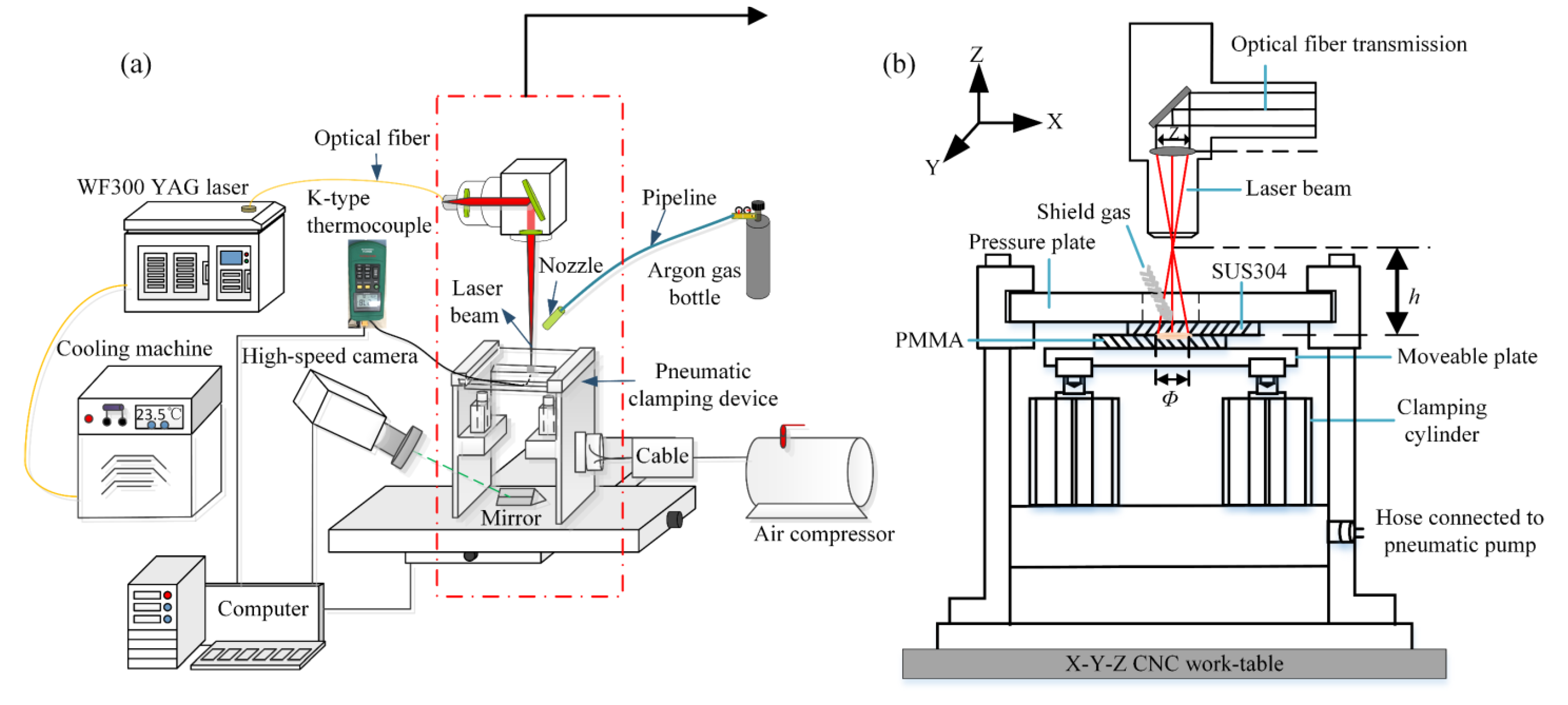
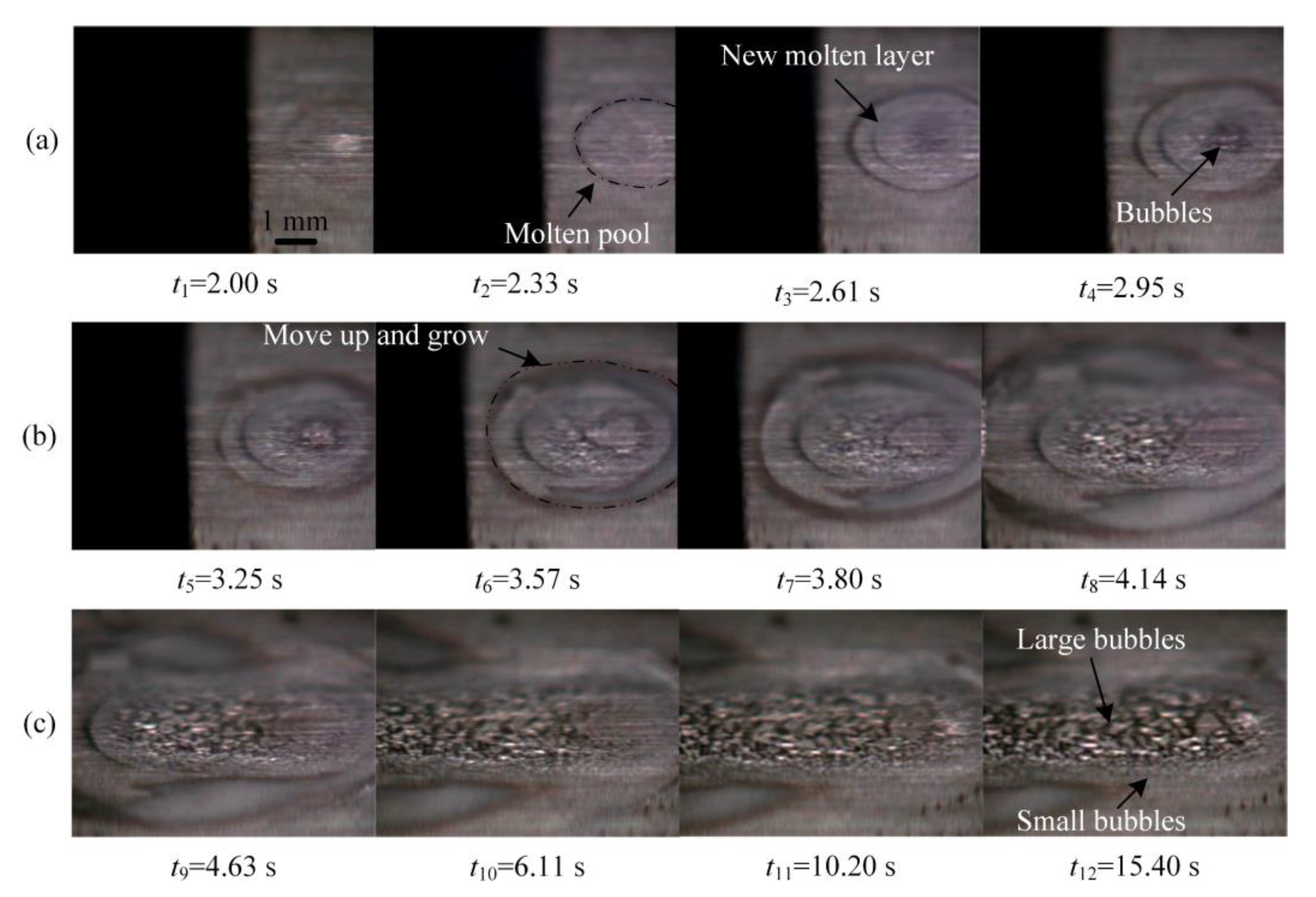
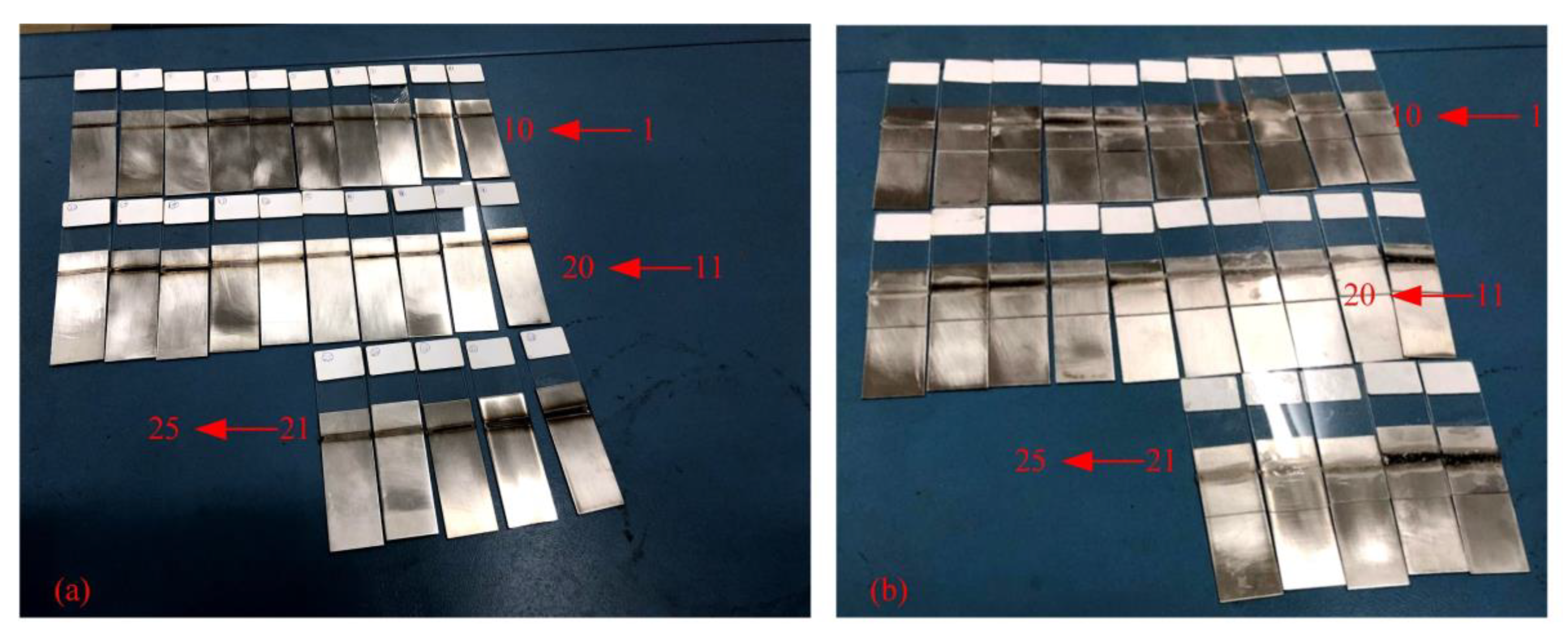



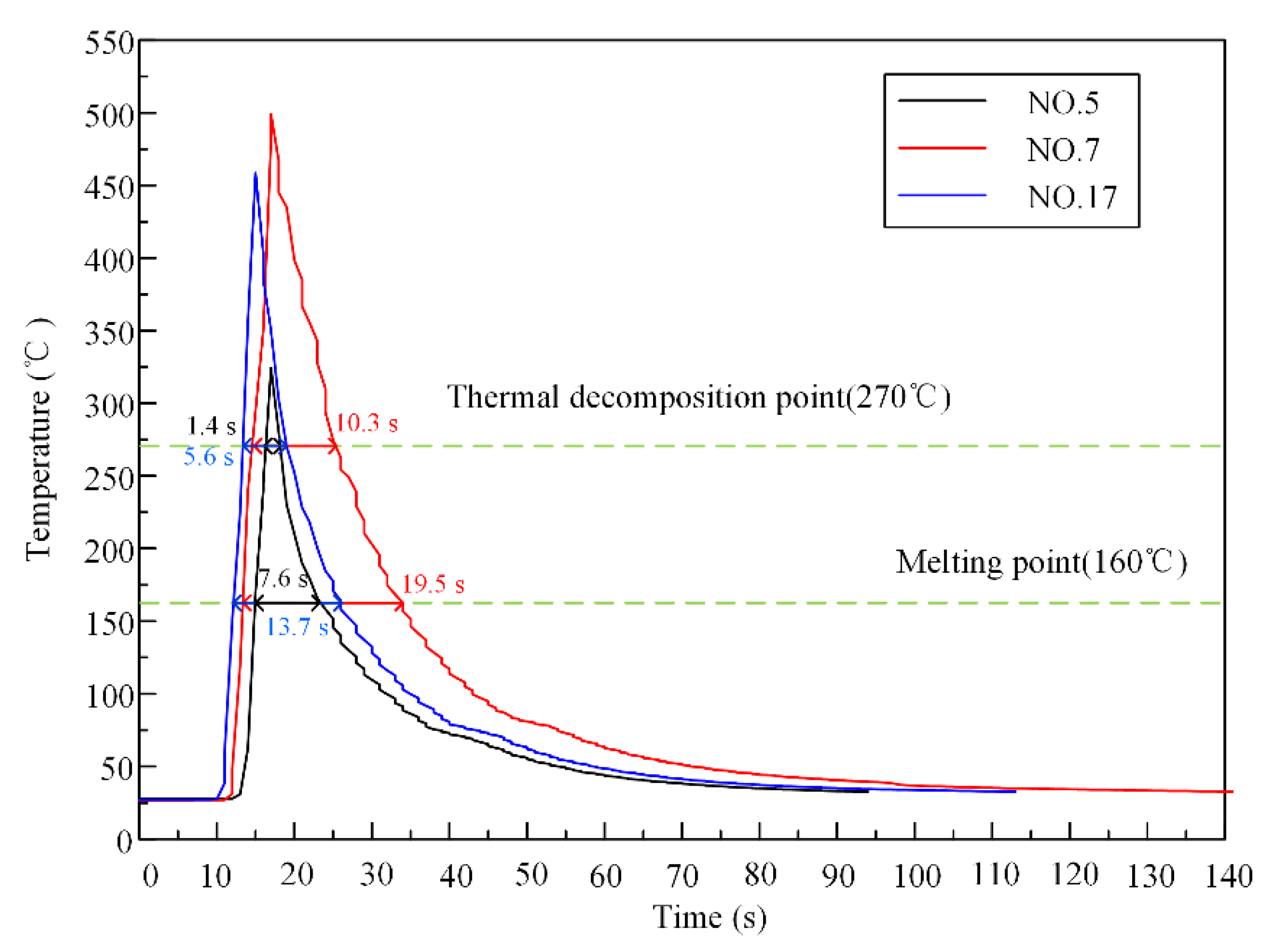
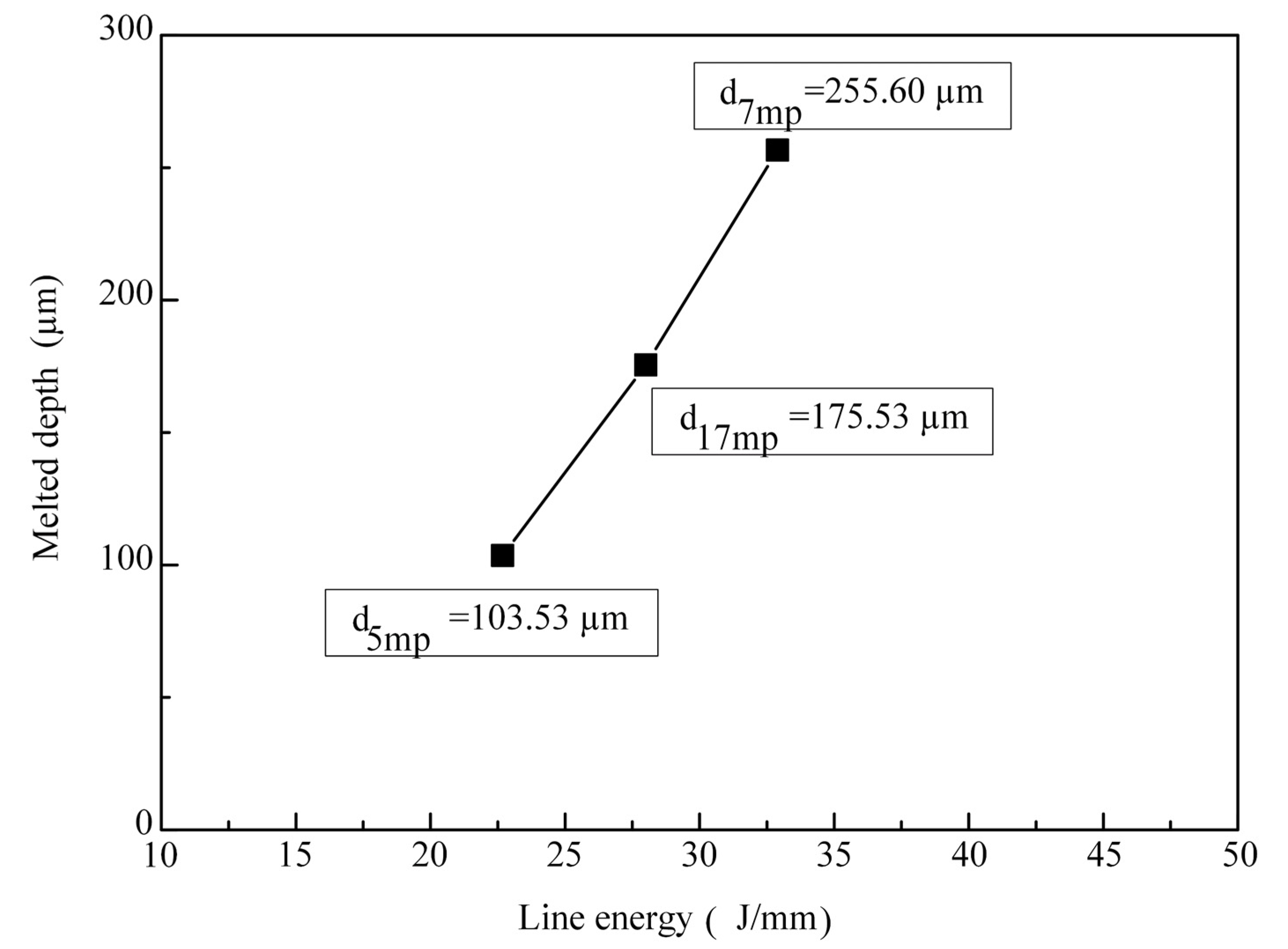

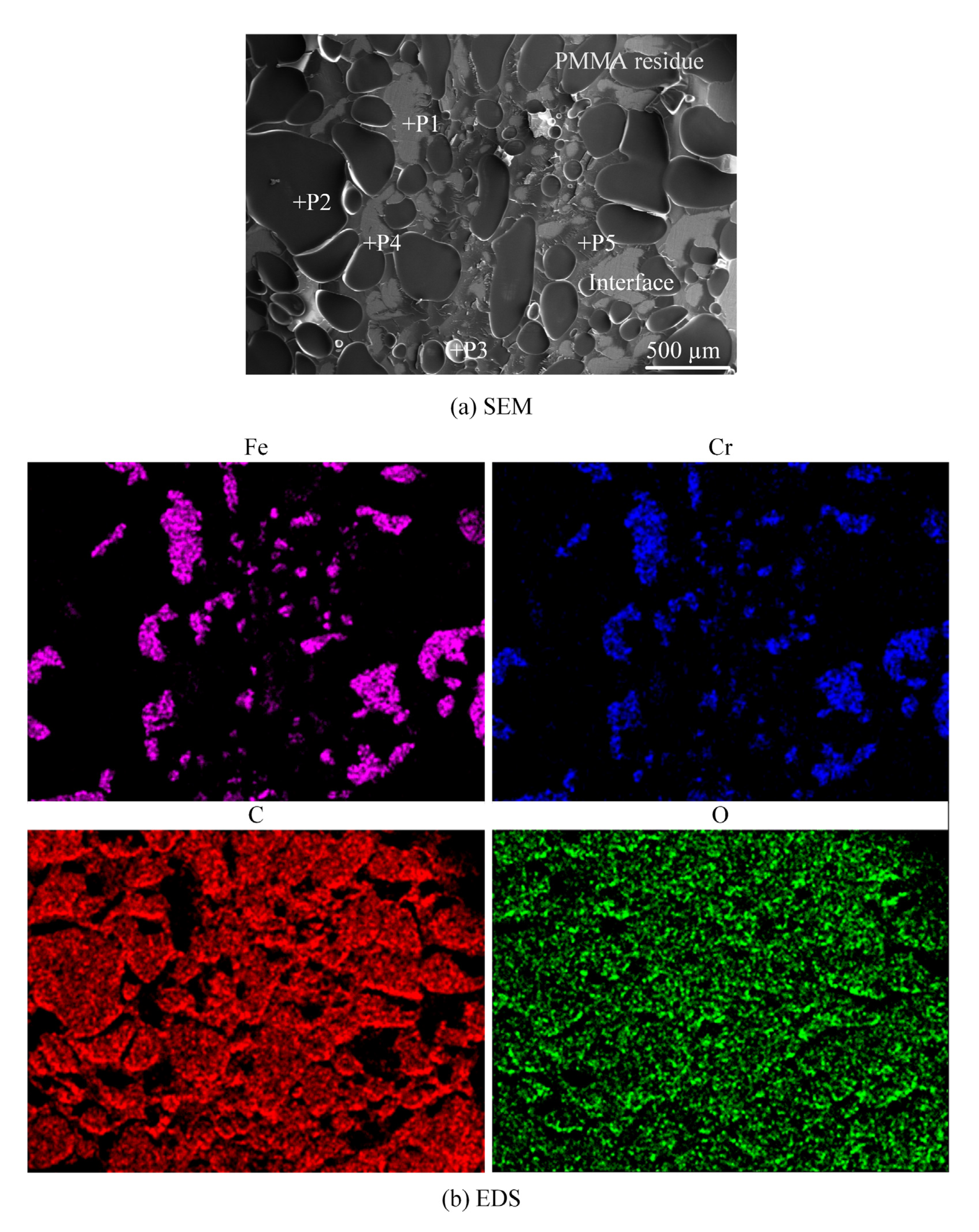

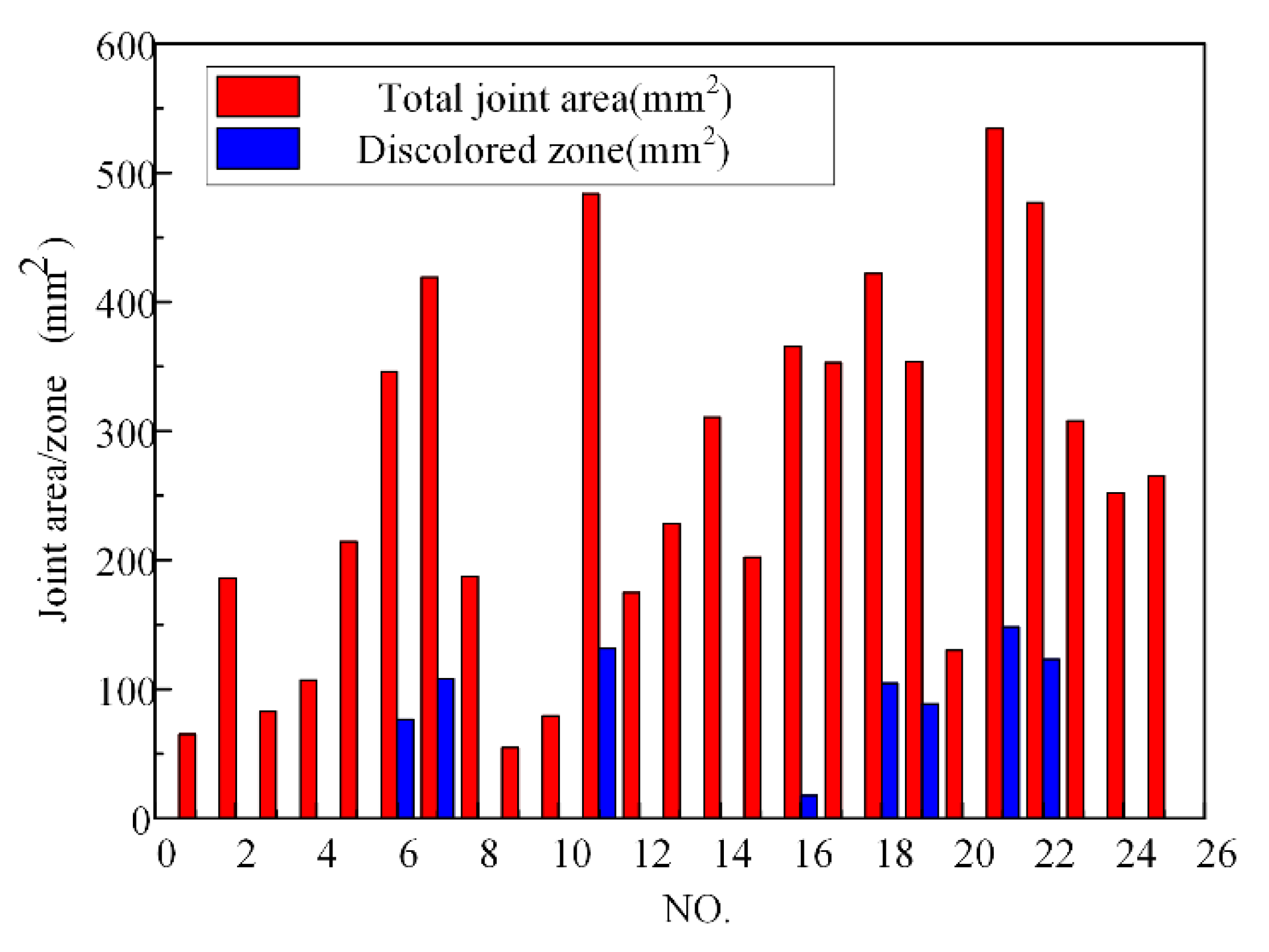
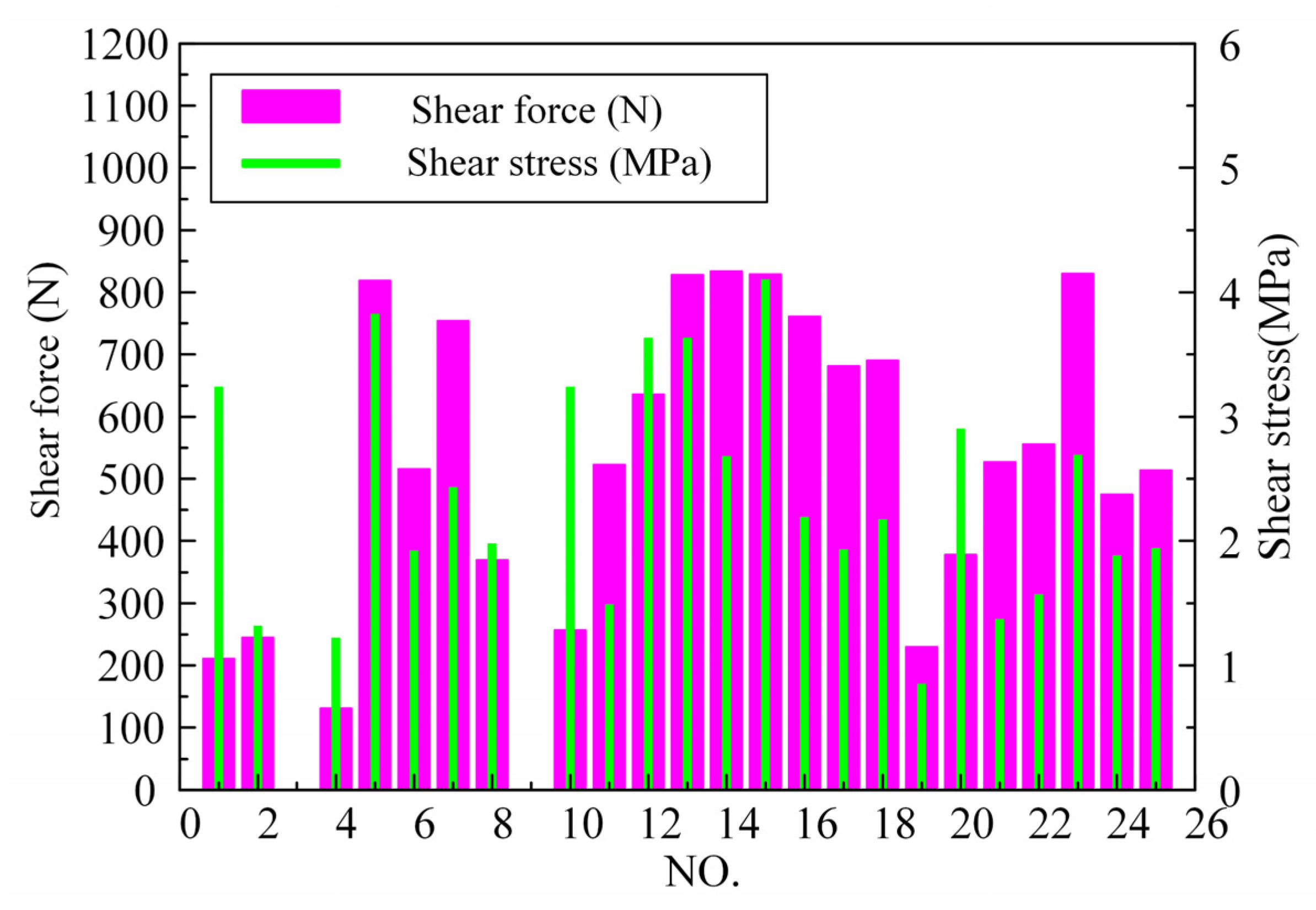
| Performance | Polymethyl Methacrylate | 304 Austenitic Stainless Steel |
|---|---|---|
| Density (kg/m3) | 1186–1190 | 7900 |
| Thermal conductivity (W·m−1·K−1) | 0.194–0.196 | 14 |
| Melting point (°C) | 540 | 1400–1425 |
| Specific heat (J·(kg·k)−1) | 1900 | 500 |
| Elongation at break (%) | 2–3 | 40 |
| Tensile strength (MPa) | 55–77 | 520 |
| Process Parameters | Units | Factor Levels | ||||
|---|---|---|---|---|---|---|
| 1 | 2 | 3 | 4 | 5 | ||
| Peak power (p) | kW | 1.4 | 1.6 | 1.8 | 2.0 | 2.2 |
| Welding speed (v) | mm/s | 3.0 | 3.5 | 4.0 | 4.5 | 5.0 |
| Beam diameter (Ф) | mm | 7.6 | 8.0 | 8.4 | 8.8 | 9.2 |
| Pulse frequency (f) | Hz | 5.0 | 6.0 | 7.0 | 8.0 | 9.0 |
| Pulse duration (t) | ms | 14.0 | 15.0 | 16.0 | 17.0 | 18.0 |
| Ar gas flows (q) | L/min | 10.0 | 15.0 | 20.0 | 25.0 | 30.0 |
| NO. | Process Parameters | Experimental Results | ||||||||
|---|---|---|---|---|---|---|---|---|---|---|
| P (kW) | v (mm/s) | h (mm) | Φ (mm) | f (Hz) | t (ms) | q (L/min) | LE (J/mm) | Tmax (°C) | F (N) | |
| 1 | 1.4 | 3.0 | 19 | 7.6 | 5 | 14 | 10 | 16.30 | 255.0 | 211 |
| 2 | 1.4 | 3.5 | 20 | 8.0 | 6 | 15 | 15 | 18.00 | 276.8 | 245 |
| 3 | 1.4 | 4.0 | 21 | 8.4 | 7 | 16 | 20 | 19.60 | 302.8 | 0 |
| 4 | 1.4 | 4.5 | 22 | 8.8 | 8 | 17 | 25 | 21.15 | 323.2 | 131 |
| 5 | 1.4 | 5.0 | 23 | 9.2 | 9 | 18 | 30 | 22.68 | 324.1 | 819 |
| 6 | 1.6 | 3.0 | 20 | 8.0 | 7 | 17 | 30 | 31.70 | 491.3 | 516 |
| 7 | 1.6 | 3.5 | 21 | 8.4 | 8 | 18 | 10 | 32.90 | 499.2 | 754 |
| 8 | 1.6 | 4.0 | 22 | 8.8 | 9 | 14 | 15 | 25.20 | 469.8 | 370 |
| 9 | 1.6 | 4.5 | 23 | 9.2 | 5 | 15 | 20 | 13.30 | 156.0 | 0 |
| 10 | 1.6 | 5.0 | 19 | 7.6 | 6 | 16 | 25 | 15.36 | 248.3 | 257 |
| 11 | 1.8 | 3.0 | 21 | 8.4 | 9 | 15 | 25 | 40.50 | 534.9 | 523 |
| 12 | 1.8 | 3.5 | 22 | 8.8 | 5 | 16 | 30 | 20.57 | 312.7 | 636 |
| 13 | 1.8 | 4.0 | 23 | 9.2 | 6 | 17 | 10 | 22.95 | 325.2 | 828 |
| 14 | 1.8 | 4.5 | 19 | 7.6 | 7 | 18 | 15 | 25.20 | 469.0 | 834 |
| 15 | 1.8 | 5.0 | 20 | 8.0 | 8 | 14 | 25 | 20.16 | 305.0 | 829 |
| 16 | 2.0 | 3.0 | 22 | 8.8 | 6 | 18 | 20 | 36.00 | 523.0 | 761 |
| 17 | 2.0 | 3.5 | 23 | 9.2 | 7 | 14 | 25 | 28.00 | 458.6 | 681 |
| 18 | 2.0 | 4.0 | 19 | 7.6 | 8 | 15 | 30 | 30.00 | 502.2 | 690 |
| 19 | 2.0 | 4.5 | 20 | 8.0 | 9 | 16 | 10 | 32.00 | 498.0 | 230 |
| 20 | 2.0 | 5.0 | 21 | 8.4 | 5 | 17 | 20 | 17.00 | 260.0 | 378 |
| 21 | 2.2 | 3.0 | 23 | 9.2 | 8 | 16 | 15 | 46.90 | 550.6 | 527 |
| 22 | 2.2 | 3.5 | 19 | 7.6 | 9 | 17 | 20 | 48.08 | 580.4 | 556 |
| 23 | 2.2 | 4.0 | 20 | 8.0 | 5 | 18 | 25 | 24.75 | 465.1 | 830 |
| 24 | 2.2 | 4.5 | 21 | 8.4 | 6 | 14 | 30 | 20.50 | 309.7 | 475 |
| 25 | 2.2 | 5.0 | 22 | 8.8 | 7 | 15 | 10 | 23.10 | 426.7 | 514 |
| Position Element | P1 | P2 | P3 | P4 | P5 | |
|---|---|---|---|---|---|---|
| (wt%) | ||||||
| Carbon | 0.000 | 70.065 | 61.742 | 73.838 | 62.677 | |
| Oxygen | 1.135 | 27.757 | 14.714 | 15.640 | 10.620 | |
| Fe | 81.645 | 1.658 | 18.318 | 8.578 | 21.400 | |
| Cr | 17.220 | 0.519 | 5.225 | 1.943 | 5.303 | |
| Target | Parameter | ||||||
|---|---|---|---|---|---|---|---|
| P (kW) | v (mm/s) | Φ (mm) | f (Hz) | t (ms) | q (L/min) | ||
| Shear stress (MPa) | 1.920 | 2.042 | 2.579 | 2.492 | 2.626 | 2.418 | |
| 1.913 | 2.175 | 2.175 | 2.452 | 1.383 | 1.469 | ||
| 3.106 | 2.093 | 1.741 | 1.694 | 1.817 | 2.152 | ||
| 2.008 | 1.327 | 2.191 | 2.258 | 2.248 | 2.113 | ||
| 1.891 | 3.200 | 2.151 | 1.942 | 2.763 | 2.685 | ||
| Rw | 1.215 | 1.873 | 0.838 | 0.798 | 1.380 | 1.216 | |
| Rank | 4 | 1 | 5 | 6 | 2 | 3 | |
Publisher’s Note: MDPI stays neutral with regard to jurisdictional claims in published maps and institutional affiliations. |
© 2021 by the authors. Licensee MDPI, Basel, Switzerland. This article is an open access article distributed under the terms and conditions of the Creative Commons Attribution (CC BY) license (https://creativecommons.org/licenses/by/4.0/).
Share and Cite
Huang, Y.; Gao, X.; Ma, B.; Zhang, Y. Interface Formation and Bonding Mechanisms of Laser Welding of PMMA Plastic and 304 Austenitic Stainless Steel. Metals 2021, 11, 1495. https://doi.org/10.3390/met11091495
Huang Y, Gao X, Ma B, Zhang Y. Interface Formation and Bonding Mechanisms of Laser Welding of PMMA Plastic and 304 Austenitic Stainless Steel. Metals. 2021; 11(9):1495. https://doi.org/10.3390/met11091495
Chicago/Turabian StyleHuang, Yijie, Xiangdong Gao, Bo Ma, and Yanxi Zhang. 2021. "Interface Formation and Bonding Mechanisms of Laser Welding of PMMA Plastic and 304 Austenitic Stainless Steel" Metals 11, no. 9: 1495. https://doi.org/10.3390/met11091495






